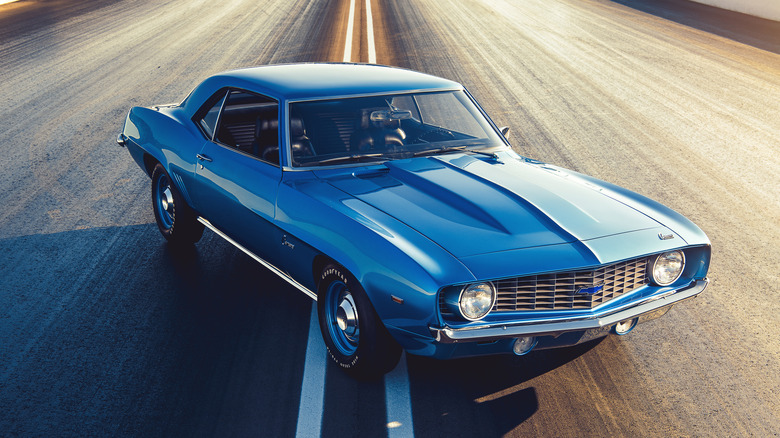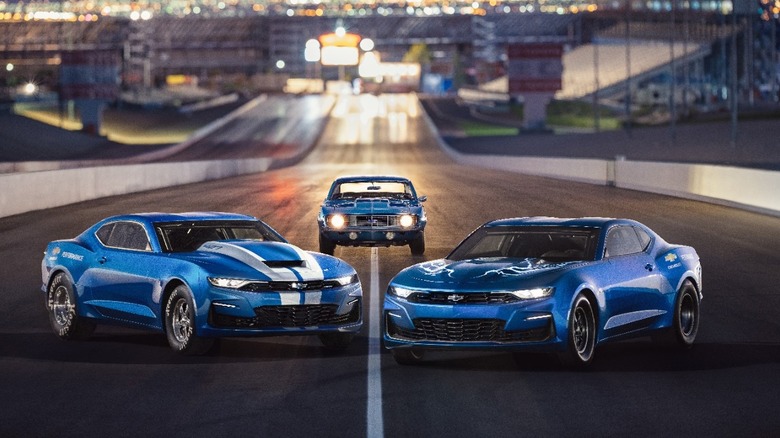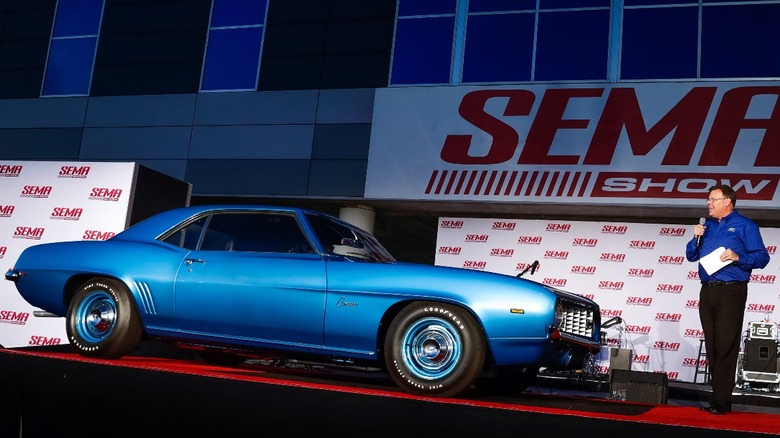What Chevrolet 'COPO' Camaro Means (And What They're Worth Today)
It's no secret that some of the most important performance cars in history were born out of exploiting loopholes. Racecars are the most obvious offenders, with the likes of the BMW M3 GTR, Porsche 911 GT1, and Toyota GT-One all earning their Le Mans fame for cheating homologation rules. However, there are also some instances when special road cars were only built due to sneaky executive decisions or determined enthusiast involvement. That's where the story of the COPO Camaro begins.
In 1969, GM's halo car was the Chevrolet Corvette. That isn't surprising, as the Corvette put GM on the map as America's only true mass-produced sports car manufacturer in the 1950s. As a result of the Corvette's golden boy status, GM punished its other divisions by forbidding them from creating a car that could be considered a threat to the Corvette's supremacy. They did that by restricting displacement in non-Corvette vehicles to 400 cubic inches. However, there was a way around that restriction in the form of the Central Office Production Order system, often abbreviated to just COPO.
The COPO system was never intended to be a means of creating unique, one-off, big-block monsters. On the contrary, it was meant to accommodate boring mass orders. The COPO system was initially created to fulfill fleet orders that required specific accommodations, such as police cars and taxi cabs. However, in 1969, dealers began discovering that the COPO system could be used to create unique variations that wouldn't normally be possible from the factory, including stuffing 427 V8s into Camaros.
What makes the COPO Camaro so special?
COPO Camaros are special for two main reasons: rarity and performance. Fred Gibb, the owner of an Illinois Chevy dealer in the late 1960s and tuner extraordinaire, is credited with being the first person to discover the COPO loophole in 1968. He first used it to custom order 50 Chevy Novas with L78 396-cubic-inch V8s under the hood, an engine that was reserved specifically for full-size Chevrolet chassis. With the Nova batch a success, he moved on to the Camaro.
In 1969, the largest engine option available for the Camaro was the formidable L89 396 big-block that produced somewhere in the ballpark of 375 horsepower (although many enthusiasts believe that was a lowball figure). However, using the COPO system, Fred Gibb was able to order 50 1969 Camaros powered by ZL1 427 cubic-inch V8s, a legendary engine that was born out of Chevrolet's NASCAR program. While the ZL1 was factory-rated at 430 horsepower, later dyno testing proved that they were actually producing closer to 550 horsepower, making the 1969 ZL1 COPO the fastest Camaro up to that point.
Word quickly got out that Frankenstein Camaros were making their way out of Midwest dealers by use of the COPO system, and a number of other dealers wanted a taste. Between Gibb and other dealers that caught wind of the program, including Berger, Nickey, and Yenko, only 69 1969 ZL1 COPO Camaros were ever built. While ZL1 COPO Camaros are unquestionably the crème of the crop, dealers also experimented with other COPO combinations, including cars equipped with the iron-block L72 427 V8 and some equipped with the Sports Car Conversion Package. With all combinations included, only 1,015 1969 COPO Camaros rolled off the assembly line before Chevrolet shut down the program the following year.
How much are COPO Camaros worth today?
Considering how iconic pieces of automotive history are snapped up by collectors, it shouldn't be surprising that 1969 COPO Camaros, especially ZL1 examples, are worth a whole lot of money. Since 2012, Chevrolet has also offered modern renditions of the COPO Camaro on both the fifth-gen and sixth-gen platforms. They carry on the legacy of the original with big-block engine options and limited production numbers. They aren't street legal, either, and are instead purpose-built racecars. While fifth and sixth-gen COPOs are rare and powerful, they don't fetch quite the same price point as the 1969 COPOs that started it all.
The average price for a 1969 COPO Camaro varies significantly on which engine and package the car is equipped with. ZL1-equipped COPO #9560 cars are unquestionably the most valuable, especially considering that there are only 69 in existence. In 2020, an original 1969 COPO ZL1 sold for $1,094,500 at a Barrett Jackson auction in 2020, making it the most valuable Camaro ever sold. Other 1969 COPOs fetch a pretty penny too, regardless of their packaging and engine. With nearly 1,000 COPO #9561 packaged cars being built in 1969, the L72 427 V8 cars are much more common and less valuable as a result, despite producing the same amount of horsepower as the ZL1 cars. Regardless, according to Classics.com, the average auction price for non-ZL1 1969 COPOs is around $162,000.
Despite a number of factors working against them, including their lack of historical significance and less unique engine options, later-generation COPO Camaros are still worth good money in the aftermarket. A 2015, LS7-powered, COPO Camaro recently sold at Mecum auction for $71,000, and a 2023 COPO equipped with the 1,004-horsepower COPO 632 just went for $147,000 in February of this year.


